Pakistan Cricket has suffered major “lows” in last 5 years due to their notorious acts. Pakistan is like a vagabond who irritates the street with his loud and notorious acts but, once he is gone, a part of you always miss him!
Pakistan has truly been a soul of this game. In every aspect of Cricket there are Pakistanis who keep the blood running in heart of Cricket. There are some astonishing and mind-boggling world records held by Pakistan. Some of those overwhelming records are:
1. Highest win/loss ratio in Home TestsPakistan’s home venues have become no-go zone for international teams due to security reasons but surprisingly Pakistan has the best home record in Test Cricket. Pakistan’s Win/Loss Ratio of
2.54 is the best among all nations. Pakistan has played 151 Tests at home; 56 won, 22 lost and 73 drawn, that gives ratio of 2.54 to Pakistan. Australia with 2.26 is second whereas Sri Lanka with 1.86 is third.

Shoaib Akhtar, who holds the record for fastest delivery ever bowled in Cricket, is ecstatic after taking wicket against South Africa
2. Fastest delivery bowled in International CricketIn ICC World Cup 2003 match between Pakistan and England at Newlands (Cape Town), Shoaib Akhtar became the first bowler to cross the barrier of 100 mphs, his delivery to Nick Knight clocked
100.4 mph/ 161.9 kmph, making it fastest delivery bowled in International Cricket. Previously Shoaib Akhtar was claimed to bowl 100 mph by Cybernet’s speed gun in a match against New Zealand in Pakistan but ICC didn’t approve it.

Go Pigeon get it, Its a SIX! The power of an Afridi
3. Most “Sixes” in ODIs and International Cricket“367” is the number of Sixes Shahid Afridi has hit in international cricket (including Tests, ODIs and T20 Int.), the most number of sixes by any batsman in International Cricket. In ODIs alone, he has hit
289 Sixes which is another world record.

He was stunning with numbers and was in his prime form in 2006; a year yielded 1788 runs and 9 centuries
4. Most runs by batsman in a calendar year of Test CricketIn 2006, Mohammad Yousuf scored 1788 runs in 11 Tests at average of 99.33. He broke the previous record of 1710 runs in 11 Tests by Viv Richards. Yousuf’s innings were against India, Sri Lanka, England and West Indies. He was in sublime form throughout the year even on hostile batting wickets of England, he scored in bulk; 631 runs in 4 Tests including a double-century and 2 centuries. During course of 1788, Yousuf also scored 665 runs in a 3 Test series against West Indies –most runs by Pakistan batsman in 3 Test series – and he hit 5 centuries in consecutive matches.
5. Nine centuries in a calendar year of Test Cricket2006 didn’t end for Yousuf by giving him most runs in a year but it also ended up giving him 9 centuries; another world record. At end of the year, in series against West Indies, Yousuf hit 4 centuries in 3 Matches which made his tally to 9 centuries in a year. Arvinda de Silva, Ricky Ponting, Viv Richards and Sachin Tendulkar have hit 7 centuries in a calendar year.

The Boom Boom goes areal! No one, in 15 years, has matched his world record
6. Fastest century in ODI Cricket15 years to date, the auspicious record is still possessed by Shahid Afridi, or should I say Boom Boom Afridi. On 4th October (1996), Shahid Afridi – playing his first ODI innings – annihilated the Sri Lankan bowling attack by scoring century of 37 balls with help of 11 Sixes and 7 Fours. In 15 years, no one has threatened to break this record. The record for 4th fastest (45 balls against India in Kanpur 2006) and 7th fastest (53 balls against Bangladesh in Dambulla 2010) centuries is also held by Shahid Afridi, 3 out of top 10 fastest centuries belong to Shahid Afridi.
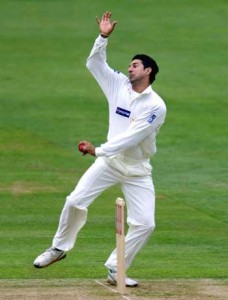
Wasim Akram was Captain's dream, fans' delight; the finest left-arm bowler Cricket has ever seen
7. Four International Hat-tricksWasim Akram leads the way with FOUR international hat-tricks; two in ODIs and two in Tests, most hat-tricks by any bowler in world. Akram’s two Test hat-tricks came in consecutive Tests against Sri Lanka which is also kind of a record however a bowler named James Mathews has taken two hat-tricks in one Test match. Wasim Akram was also the first Pakistani to take hat-trick in Test Cricket.
8. A Hat-trick in Test Cricket as well as ODI CricketWasim Akram and Mohammad Sami are only two cricketers who have taken hat-trick in ODIs as well as in Tests. Mohammad Sami, surprisingly, has hat-trick against Sri Lanka in Tests and against West Indies in ODIs. There isn’t any bowler in World who has taken a hat-trick in all three formats of the game however Brett Lee, the Australian fast bowler, has taken a hat-trick in ODIs and Twenty20 Int.
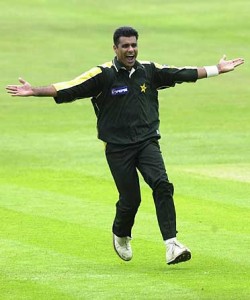
Waqar Younis on his day - with banana-swing - was a bomb waiting to blast!
8. Most five-wicket hauls in ODI CricketWaqar Younis has taken
13 five-wicket hauls in 262 ODIs; a record of most-wicket hauls by any bowler in ODIs, not only this, he also has record for taking most 4+ wickets in ODIs; 27 times he has taken 4+ wickets in ODI Cricket.
9. Fastest to reach 100, 150, 200 and 250 ODI wicketsAll the tallies belong to one man. Perhaps the best spinner ODI Cricket has ever seen. Saqlain Mushtaq, the off-spinner of Pakistan, has record for being the fastest to reach 100, 150, 200 and 250 ODI wickets. He also has two hat-tricks in ODIs; joint record with Wasim Akram, Chaminda Vass and Lasith Malinga.
10. Most wickets in a calendar year of ODIsIn 1996, Saqlain Mushtaq took 65 wickets in 33 ODIs which was record at that time. A year later, in 1997, he bettered his record with 69 wickets in 36 ODIs. To date, Saqlain’s tally of 69 wickets in a year remains the world record for most wickets in a calendar year of ODI Cricket.
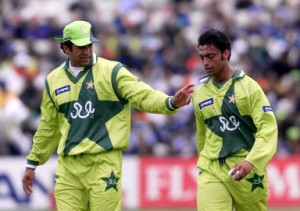
The master and the pupil in tandem; Wasim taught Shoaib how to draw first blood!
11. Most ODI Wickets on a single groundWasim Akram has taken 122 wickets in 77 Matches at Sharjah, that’s record for most wickets by a bowler on a single venue. Second comes another Pakistani with Waqar Younis taking 114 wickets in 61 matches also at Sharjah. None other than “ The Ws” has taken 100 or more wickets on a single venue in ODI Cricket.

My eyes become wet when I see this picture. Trust me! He is world-beater of the game
12. Most “Sixes” by batsman in an innings of a TestWasim Akram, in course to his famous 257* against Zimbabwe in Sheikhupura 1996, hit
12 Sixes. Surprisingly its a World Record effort. He broke the record of Wally Hammod’s 10 sixes of an innings in 1933. Later Nathan Astle (in 2002) and Mathew Hayden (in 2003) hit 11 sixes of their innings against England and Zimbabwe respectively.
13. 400 Test Wickets and a Double-centuryWasim Akram, to date, is only Cricketer to have taken 400 wickets and to score a double-century in his Test career. He grabbed 414 Tests wickets and scored double-century, 257*, against Zimbabwe. Akram is also one of few cricketers –Abdul Razzak and James Franklyn are others which I can recall – to have scored a century and taken a hat-trick in Tests. Akram’s two Test hat-tricks and a double-century also give him an unique all-rounder record.
14. Seven players of batting line-up’s top-order scoring 50+ in a Test inningsIn Pakistan’s famous Test victory against India in Karachi 2006, seven Pakistan batsman scored 50+ runs in second innings. In first innings Pakistan were bowled out on 245 but in second innings Pakistan scored 599-7 (declared) with all 7 batsmen who were out scoring 50+ runs. Salmam Butt (53), Imran Farhat (57), Younis Khan (77), Mohammad Yousuf (97), Faisal Iqbal (139), Shahid Afridi (60) and Abdul Razzak (90) were part of this record.
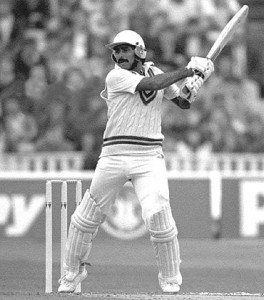
Javed Miandad was the anchor always prepared for a storm; most consistent match-winner of his era
15. Nine consecutive fifties in ODI CricketBetween March and October of 1987, Javed Miandad scored 9 fifties in consecutive ODIs. Javed’s innings were 78 , 78*, 74*, 60, 52*, 113, 71*, 68 and 103. He is the only batsman to go that far as second best is 6 consecutive fifties by Gordon Greenidge.
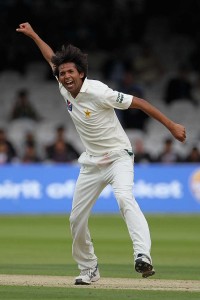
Asif had a brain of real craftsman; who could beat you anywhere in any format of the game. He made the ball to talk in every way possible
16. First maiden in Twenty20 InternationalsMohammad Asif, Pakistan fast bowler, has distinction of bowling the first ever maiden-over in history of Twenty20 Internationals. On 28th August 2006, Asif bowled maiden over against England in Bristol and also took 2 wickets in that over. Astonishingly, it was also Pakistan’s first ever appearance in Twenty20 Internationals.
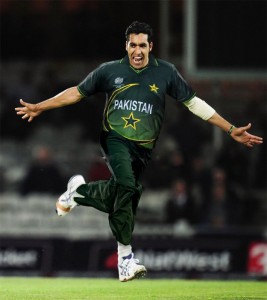
Umar Gul; they call him slave of rhythm and king of yorkers
17. Best bowling figures in Twenty20 InternationalsUmar Gul’s 5-wicket haul against New Zealand in ICC World T20 2009 stands as finest spell bowled in Twenty20 Internationals. He took 5 wickets for 6 runs in his 3 overs, these are best figures by a bowler in Twenty20 Internationals.
18. Best bowling figures in Twenty20 CricketIn first edition of Indian Premier League in 2008, Pakistan left-arm fast bowler Sohail Tanvir took 6 wickets for 14 runs in a match against Chennai Super Kings while playing for Rajhastan Royals. To date, 4-0-14-6 remains the best bowling figure by any bowler in Twenty20 Cricket.
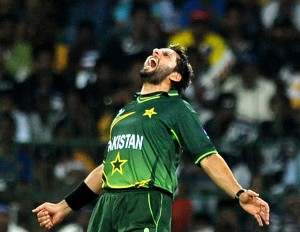
Stupendous Afridi is a thunderbolt in go!
19. Most Wickets in Twenty20 InternationalsStar Pakistan all-rounder Shahid Afridi leads the way with 53 wickets in 43 T20 Internationals, most wickets, so far, by any bowler in Twenty20 Internationals. He is also the first, and last so far, to take 50 wickets. Second and third are also Pakistanis, Umar Gul (47 wickets in 34 matches) is second whereas Saeed Ajmal (43 wickets in 30 matches) is third.
20. Youngest to take 5-wicket haul and most consecutive 5-wicket hauls in ODIsWaqar Younis also holds the record for being youngest bowler to take 5 wickets in an ODI. In 1990, at age of 18 years and 164 days, Waqar took 6 wickets for 26 runs in a match against Sri Lanka at Sharjah. Second youngest is also a Pakistani as Wasim Akram, at age of 18 years and 266 days, took 5 wickets for 21 runs against Australia in Melbourne 1995.
In 1990, Waqar Younis also took three consecutive 5-wicket hauls in ODIs. None other than Waqar has taken 5-wicket hauls for three consecutive times. Waqar also took 7 wickets for 36 runs against England at Leeds in 2001, that remains the best bowling figure, in ODIs, by captain.
21. Highest partnerships for first and second wicket in First Class CricketWaheed Mirza and Mansoor Akhtar hold the record for highest opening partnership in First Class Cricket, both added 561 as openers in Karachi 1976-77. Record for highest second-wicket partnership also belongs to Pakistan’s pair of Aamir Sajjad and Rafatullah Mohmand; they added 580 for second wicket against Sui Southern Gas Corporation while playing for WAPDA in 2009.
22. Youngest to make Test and ODI DebutsHassan Raza, at age of 14 years 227 days, became the youngest player to make play a Test match. He debuted against Zimbabwe in Faisalabad in October 1996. Second and third youngest to make Test debut are also from Pakistan; Mushtaq Mohammad and Aqib Javed made their Test debuts at age of 15 years 124 days and 16 years 189 days respectively.
Hassan Raza, at age of 14 years 233 days, also became the youngest to play an ODI Match. He made his debut against Zimbabwe in Quetta in October 1996.
23. Youngest to score century in ODIsShahid Afridi’s maiden ODI century was not only the fastest it was also a century by youngest player in ODI Cricket. Afridi aged 16 years 217 days amassed century of 37 balls against Sri Lanka at Nairobi in 1996. 6 out of top 10 youngest players to score ODI century are from Pakistan.

The young bowler, who was in his new flights, cut his wings himself. He is younget fast-bowler to have 5 wicket-haul in Tests. Miss you!
24. Youngest to take 5-wicket haul in TestsIn 1958, slow left-arm orthodox bowler Nasim-ul-Ghani took 5 wickets for 116 runs, at age of 16 years 303 days, against West Indies in Georgetown. The 5-wicket haul made him youngest bowler to achieve this feat. He was also youngest player to make Test debut at that time.
Moreover, another young Pakistan fast bowler Mohammad Aamir is youngest fast bowler to take 5 wickets in an Test innings. In December 2009, at age of 17 years 257 days, Aamir became the youngest fast bowler and second youngest bowler to take 5 wickets; he took 5 wickets for 79 runs against Australia in Boxing Day Test of 2009.
25. Youngest player to score double-century in Test CricketAt age of 19 years 140 days, Javed Miandad became the youngest batsman to score a double-century in Test Cricket. In October 1976, Miandad scored 206 runs against New Zealand in Karachi.
26. Youngest bowler to take hat-trick in ODI CricketAaqib Javed at age of 19 years 81 days became the youngest bowler to take hat-trick in ODIs. In Final of Sharjah Cup October 1991, Aqib Javed ripped apart Indian batting and claimed 7 wickets for 37 runs including a hat-trick. Ravi Shastri, Azharuddin and Tendulkar were victims of his hat-trick; all were out LBW. Aqib’s figures of of 7 for 37 were the best bowling figures of that time.

Hanif, the little master, was one of four brothers to play Test Cricket for Pakistan, a world record itself!
27. Only triple-century in second innings of the teamThere have been many triple-centuries scored in Test Cricket but, to date, Hanif Mohammad’s 337 against West Indies in Bridgetown 1958 remains the only incident of a batsman scoring triple-century in second innings of the team. In his marathon innings, Hanif Mohammad batted for 970 minutes which is another World Record of longest Test innings played with-respect-to Minutes.
In same match, Pakistan were bowled out on 106 in first innings. In follow-on innings, Pakistan scored 657-8 (declared). The difference of 551 between two innings is the largest difference between a team’s first and second innings; a world record itself.
Now some joint records by Pakistan28. Highest tenth-wicket partnership in Test CricketIn 1997 against South Africa, pair of Azhar Mahmood and Mushtaq Ahmad added 151 runs for tenth wicket in Rawalpindi. Azhar Mahmood also scored century on debut in same match. The tally of 151 equaled the record by Hastings and Colling who also scored 151 for tenth-wicket against Pakistan in Auckland 1973.
29. Twin-centuries on Test DebutYasir Hameed is the only second batsman to score two-centuries on Debut. He scored 170 and 105 in his debut against Bangladesh in Karachi 2003. Lawrence Rao, of West Indies, is the only other batsman to score twin-centuries on debut; Rao also scored double century in one innings.
30. Maintaining average of 50 throughout batting careerJaved Miandad, along with Herbert Sutcliffe, is the only batsman in Test Cricket whose batting average never fell below 50. Miandad ended his career with batting average of 52.57, scoring 8832 runs in 124 Tests.
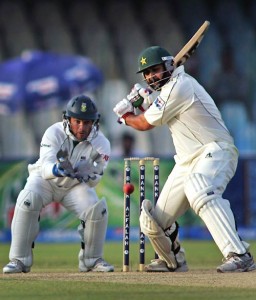
Cut, slice, pull, drive, smash, push, hook, sweep; Inzamam did all of them with his sheer class. Stunning resistor, he was!
31. Five batsmen scoring centuries in a Test InningsIn August 2003 at National Stadium Karachi against Bangladesh, Five batsmen of Pakistan’s batting line-up scored centuries, making it only second instant; first Australia’s five batsmen scored centuries in an innings. Saeed Anwar (101), Tafueer Umar (104), Inzamam-ul-Haq (105), Mohammad Yousuf (102*) and Abdul Razzak (110*) were part of this record.
Written and compiled by: Mazher Arshad [ www.facebook.com/mazher157 ]














